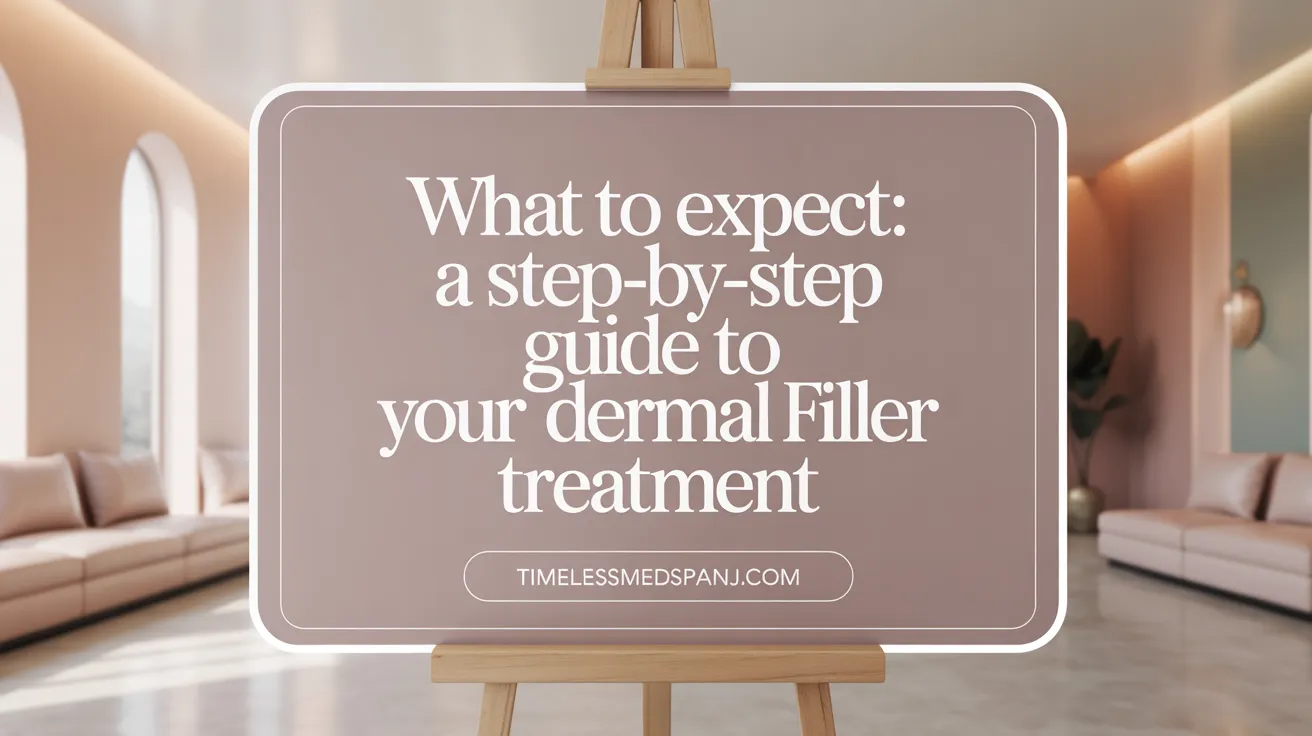Understanding Dermal Fillers: Overview and Purpose
Dermal fillers have become a popular non-surgical option for those seeking to restore youthful contours and reduce visible signs of aging. Whether targeting wrinkles, sagging skin, or loss of facial volume, these injectable treatments offer immediate and natural-looking enhancement. Before booking your appointment, it’s important to understand what dermal fillers are, how they work, and what to expect throughout the process to make an informed decision about your facial rejuvenation journey.
What Are Dermal Fillers and How Do They Enhance Your Appearance?
What are dermal fillers and what is their primary purpose?
Dermal fillers are gel-like substances injected beneath the skin to help restore facial volume, smooth out wrinkles, and improve overall facial contours. Typically made from biocompatible materials such as hyaluronic acid, calcium hydroxylapatite, or poly-L-lactic acid, these treatments are designed to address signs of aging and enhance natural beauty.
The primary purpose of dermal fillers is to re-volumize areas of the face that have lost fullness due to aging, sun exposure, or other factors. Commonly targeted regions include the cheeks, lips, under-eye hollows, nasolabial folds, and jawline. By injecting these substances, practitioners can produce immediate visible results, making the face look more youthful, refreshed, and balanced.
Different types of fillers vary in duration and effects. For instance, hyaluronic acid fillers provide immediate results that typically last between 6 months and a year, while poly-L-lactic acid stimulates collagen production gradually, with effects lasting two years or more. This variety allows patients to choose options suited to their aging concerns and desired longevity.
Overall, dermal fillers serve as a minimally invasive alternative to surgical procedures, offering quick, effective improvements that can boost confidence. When performed by skilled professionals, they provide natural-looking results, helping individuals achieve a rejuvenated appearance with minimal downtime.
However, it’s important to be aware of potential risks, such as swelling, bruising, or uneven results, underscoring the importance of consults with experienced providers who follow safety standards.
Types of Dermal Fillers: Understanding Your Options

What types of dermal fillers are commonly used and how do they differ?
Dermal fillers come in various formulations, each suited to different cosmetic needs. The most popular are hyaluronic acid (HA) fillers, such as Juvéderm and Restylane, valued for their softness, reversibility, and ability to attract water, making them ideal for lip augmentation, smoothing shallow wrinkles, and adding volume to certain facial areas. These fillers typically last about 6 to 18 months.
Calcium hydroxylapatite-based fillers like Radiesse are used for deeper contouring and stimulating collagen over time. They tend to last around a year and are effective for restoring volume in cheeks and jawlines.
Poly-L-lactic acid (PLLA), found in products like Sculptra, works gradually by encouraging the body's collagen production. Visible improvements develop over several weeks to months, with results lasting two years or more.
Another option is polymethylmethacrylate (PMMA), a semi-permanent filler composed of microspheres suspended in a collagen or water-based gel. It offers long-lasting correction for deep wrinkles and scars but requires precise application, owing to its semi-permanent nature.
Autologous fat injections utilize the patient's own fat collected via liposuction and injected at target sites. Its longevity varies, with the potential for permanent results, but it demands more invasive procedures.
Differences in composition and how they affect results
| Filler Type | Main Ingredient | Duration of Results | Main Uses | Additional Notes |
|---|---|---|---|---|
| Hyaluronic Acid | Hyaluronic Acid | 6-18 months | Lip fillers, fine lines | Reversible, hydrating effect |
| Calcium Hydroxylapatite | Calcium Hydroxylapatite | About 1 year | Deep wrinkles, contouring | Adds volume and stimulates collagen |
| Poly-L-lactic Acid | Synthetic Collagen Stimulator | 2+ years | Facial volume, age-related volume loss | Gradual, collagen-building |
| PMMA | Microspheres + Collagen | Long-term | Deep scars, wrinkles | Semi-permanent, needs experienced injector |
| Autologous Fat | Patient's Fat | Variable, potentially permanent | Volume loss in face | Requires liposuction |
Immediate versus gradual effects
Most hyaluronic acid fillers provide immediate volume and wrinkle smoothing, with visible results right after injection. In contrast, poly-L-lactic acid (Sculptra) induces collagen production gradually, with optimal results appearing over weeks to months. This makes it suitable for more subtle, natural aging correction.
Safety considerations for different fillers
When administered by trained professionals, all dermal fillers are generally safe, but each type carries specific considerations. HA fillers have the advantage of reversibility with hyaluronidase if needed. Calcium hydroxylapatite and PMMA are generally safe but require precise placement by experienced practitioners to prevent lumps or asymmetry. PLLA's gradual effect minimizes sudden changes but needs multiple sessions for optimal results. Overall, selecting the right filler depends on individual goals, treatment area, and medical history, underscoring the importance of expert consultation.
The Science Behind Dermal Fillers: How They Work to Rejuvenate Skin
How do dermal fillers work to improve the appearance of the skin?
Dermal fillers enhance skin appearance by both physically restoring volume and biologically stimulating skin renewal. They are injected beneath the skin to fill wrinkles, depressions, and hollow areas such as the cheeks, lips, and under-eye hollows.
Many fillers contain hyaluronic acid, a substance naturally found in skin tissues. Hyaluronic acid attracts water molecules, helping to hydrate and plump the skin immediately after injection. This hydration not only adds volume but also improves skin texture and elasticity.
Beyond hydration, dermal fillers often stimulate collagen production. Collagen is a protein critical to skin firmness and youthful elasticity. As the body reacts to certain fillers like poly-L-lactic acid and calcium hydroxylapatite, it increases collagen synthesis, resulting in longer-lasting improvements in skin quality.
Some fillers work through physical displacement—like silicone or permanent microspheres—to provide immediate volume. However, these may sometimes cause foreign body reactions and are less commonly used today.
Overall, dermal fillers deliver quick results by filling in lines and augmenting contours, while also promoting ongoing tissue regeneration that enhances skin strength and resilience over time. This combination of immediate and long-term effects results in a more youthful, smoother, and naturally revitalized skin appearance.
Preparing for Your Dermal Filler Appointment: Essential Tips

How should patients prepare before receiving dermal filler treatment?
Preparing adequately can help ensure optimal results and minimize risks during your dermal filler procedure. It is recommended to schedule your appointment at least four weeks before any special events. This allows time for swelling, bruising, or redness to subside, and for your results to settle.
Patients should avoid blood-thinning medications such as aspirin, warfarin, and NSAIDs like ibuprofen and naproxen for at least a week prior to treatment. Similarly, certain supplements like fish oil, vitamin E, and herbal remedies that increase bleeding risk should be stopped to reduce bruising. Limiting alcohol intake and retinoids such as Retin-A one week before the procedure is advised to avoid skin sensitivity.
For additional help with bruising, some patients take natural remedies like Arnica Montana or consume pineapple, as these may promote healing. It’s also vital to disclose any medical conditions, allergies, or history of cold sores, herpes, or active infections to your provider. This information helps the provider formulate a safe and effective treatment plan.
In the days leading up to your appointment, avoid invasive skin treatments, facial microdermabrasion, or dental work to prevent skin irritation or infection.
On the day of treatment, arrive with a clean face—free of makeup, lotions, and skincare products. Hydration is important; drinking plenty of water helps keep your skin in good condition and may improve healing. Wearing loose, comfortable clothing and avoiding caffeine or stimulants can aid relaxation.
Post-procedure, following your provider’s advice is crucial. This includes avoiding strenuous activity, heat, sun exposure, and massage of the area for several days. These steps help reduce swelling, bruising, and risk of complications, ensuring you get the best results from your dermal filler treatment.
What to Expect During the Dermal Filler Procedure

Step-by-step treatment process
The dermal filler procedure begins with a thorough cleansing of the targeted area. The provider may apply a topical anesthetic or numbing cream to reduce discomfort. Once the area is numb, the practitioner marks precise injection points according to the patient's aesthetic goals. Small amounts of the filler, often hyaluronic acid, are then injected using fine needles or cannulas. The sessions are quick, typically lasting between 15 to 30 minutes.
Duration and setting
These treatments are performed in a clean, professional office environment, often in a clinic specializing in cosmetic procedures. Because the process is minimally invasive and quick, most patients find it convenient to fit into their schedules, often during a lunch break.
Pain management techniques
Pain is minimized through the use of numbing agents, either topical or mixed into the filler itself. The injections usually feel like a quick pinch or slight pressure. For added comfort, some clinics might use ice or vibration devices during the injections.
Injection areas and volume considerations
Common areas include the lips, cheeks, nasolabial folds, and under-eye hollows. The volume of filler used depends on the desired correction, but the goal is to achieve a natural enhancement without overfilling. Skilled practitioners carefully assess and tailor the amount of filler injected to each patient's facial anatomy.
Immediate visible results and side effects
Many patients notice an immediate improvement in facial contour, volume, and wrinkle reduction following the injections. While results are apparent right away, some side effects like redness, swelling, or bruising may occur, typically resolving within a few days. These minor reactions are normal and temporary, making the procedure both effective and safe when done by trained professionals.
Post-Treatment Care and Recovery: Supporting Your Results

What are the recommended post-treatment care and recovery guidelines after dermal filler injections?
Following dermal filler procedures, proper care is vital to support healing and ensure long-lasting, natural-looking results. The initial days after treatment typically involve managing minor side effects like swelling, bruising, and redness.
To reduce these effects, applying cold compresses or ice packs to the treated areas for the first 12 to 24 hours is highly recommended. This helps minimize swelling and eases discomfort. Patients should also stay well-hydrated and avoid alcohol, strenuous exercise, hot environments, and exposure to direct sunlight for at least 24 to 72 hours.
It’s important to avoid touching, massaging, or applying pressure to the treated areas to prevent displacement of the filler. Refraining from makeup, facial treatments, or dental work for at least two weeks further protects the site and reduces the risk of infection.
Sleeping with the head elevated can help reduce swelling overnight. Mild discomfort or tenderness can be managed with over-the-counter pain relievers like acetaminophen, but non-steroidal anti-inflammatory drugs (NSAIDs) should be avoided unless approved by your provider.
Scheduling a follow-up appointment around four weeks after treatment allows your provider to evaluate your results and make any necessary adjustments. Overall, adhering to these guidelines helps promote smooth healing and optimizes your aesthetic outcome.
Safety, Benefits, and Common Concerns About Dermal Fillers

What safety considerations should be taken into account when choosing dermal fillers?
Selecting the right provider and product is crucial for safe dermal filler treatments. It is important to work with a qualified, experienced healthcare professional who is trained in administering fillers and uses FDA-approved products from reputable manufacturers.
Before the procedure, discuss your medical history, allergies, and any autoimmune conditions, as certain materials can cause hypersensitivity or granulomas. The provider should follow strict sterile techniques during injections to prevent infections.
Understanding the potential short-term effects such as bruising, swelling, and redness, as well as serious but rare risks like vascular occlusion, tissue necrosis, or even vision issues, is vital for informed consent. Ensure that there is a plan in place for managing complications, including access to reversal agents like hyaluronidase for hyaluronic acid fillers.
Avoid unapproved or DIY fillers, which can carry higher risks of adverse events. Transparency about the procedure and post-care plan with the provider enhances safety.
What are the main benefits of dermal filler treatments?
Dermal fillers offer quick, noticeable improvements with minimal downtime. They effectively reduce wrinkles, fine lines, and sagging skin, restoring facial volume for a youthful appearance.
These treatments can enhance facial contours, such as lips, cheeks, and jawline, helping achieve better facial harmony. Many fillers stimulate collagen production and add hydration, resulting in smoother, firmer skin over time.
Results are immediate, and depending on the type of filler used, they can last from several months to over two years. This combination of convenience and effectiveness makes fillers a popular non-surgical option for facial rejuvenation.
What common concerns or questions do people have about dermal filler treatments?
Patients frequently worry about side effects like bruising, swelling, or allergic reactions, which are usually temporary and mild. The duration of results is another common question, with most fillers lasting between six months to two years.
Pain during injections is a concern, but providers often use numbing creams or include lidocaine in the filler to reduce discomfort. Safety is paramount, so choosing a qualified professional significantly minimizes risks like lumps, asymmetry, or skin discoloration.
Post-treatment, patients ask about recovery time, managing side effects, and follow-up care. Overall, education about the procedure helps address these concerns and supports confident decision-making.
| Aspect | Details | Additional Notes |
|---|---|---|
| Commonly Used Products | Hyaluronic acid, calcium hydroxylapatite, poly-L-lactic acid | Different fillers have varying durations and uses |
| Recovery Time | Mild swelling and bruising last a few days | Minimal downtime, avoid strenuous activities |
| Expected Duration | 6 months to over 2 years | Depends on filler type and individual physiology |
| Serious Risks | Vascular occlusion, tissue necrosis, rare vision problems | Require immediate medical attention |
| Post-treatment Tips | Avoid touching, strenuous activity, sun exposure | Follow provider instructions for best results |
Making an Informed Choice About Dermal Filler Treatments
Dermal fillers offer a versatile and effective way to rejuvenate the face, restore volume, and soften wrinkles without surgery. By understanding the different types of fillers, their mechanisms, and the procedure involved, patients can better prepare for their treatment and optimize outcomes. Careful pre-treatment preparation, a skilled provider, and diligent post-treatment care are key factors for safety and satisfaction. Addressing common concerns and knowing what to expect empowers individuals to confidently pursue dermal filler treatments to enhance their natural beauty and boost self-confidence. Always consult a licensed professional for personalized advice tailored to your unique aesthetic goals and health profile.
References
- How to Prepare for Your First Dermal Filler Appointment
- How to Prepare for Your First Dermal Filler Treatment
- Dermal Fillers: What They Are, Types, Benefits & Side Effects
- The Guide to Dermal Fillers - Center for Advanced Eye Care
- What to Know Before Getting Dermal Fillers
- Preparing for Dermal Fillers: Your Complete Treatment Guide
- What to Know Before Your First Filler Appointment
